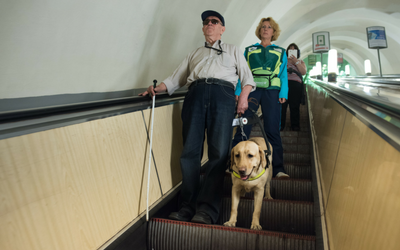International Guide Dog Day is a day to recognize and celebrate the selfless work that guide dogs do: devoting their lives to assisting those with vision impairment safely and successfully navigate the world. Guide dogs help people with vision loss move confidently through the world around them and partake in normal, everyday activities that sighted people may take for granted.
Guide dogs are highly skilled and trained animals that promote independence and safety for their owners. Guide dogs help their owners use public transportation, negotiate obstacles both high and low, guide them through busy public places, and complete many other specific daily tasks. Guide dogs are generally trained to escort their owners in a straight line while avoiding obstacles, and will stop at curbs, doors, stairs, and more. They are not intended to “lead” their owner and dictate where to go; they are trained to take instruction on where their owner wants to go, and ensure they reach their destination safely. It’s up to the owner to use their other senses—such as hearing—to determine when it’s safe to proceed (e.g., when crossing a busy intersection), give the guide dog the appropriate command, and have the dog proceed if it’s safe to do so.
Through the course of their training, guide dogs are taught to reason and respond to unsafe commands with something called intelligent disobedience; if it’s unsafe to proceed, the guide dog will refuse to obey the command. The owner in turn must learn to have faith that if their dog refuses to obey a command, it’s because there is some element of risk that the dog has identified and is reacting to.
Aside from keeping their owners safe, guide dogs provide companionship and encourage social inclusion for their owners; they boost confidence and self-esteem through enablement. The dog itself provides its owner with that very special human-animal bond that we know is so important. By enabling their owner to safely and confidently navigate public spaces, a guide dog can also promote an increased desire to leave the comforts of home and engage with other people in social situations. This can lead to establishing relationships that, without the assistance of a guide dog, the owner may not have been willing or able to create or participate in.
Dogs that are well-suited to this type of work usually have a quiet and calm disposition, a high level of intelligence, good concentration, and a strong drive to work. Breeds that are commonly used as guide dogs are Golden Retrievers, Labrador Retrievers, and German Shepherds as their intelligence, size, and temperaments make them well-suited to service work. Guide dogs receive about two years of training and socialization to learn the various tasks, obedience, and public access manners needed to be a successful guide.
Guide dogs devote their lives to keeping their owners safe and elevating their quality of life. It’s important to recognize the role they play in our society and the impact of the service they provide. For more information on getting involved with guide dog programs, or obtaining a guide dog for yourself, contact your local guide dog organization or speak with your veterinarian.
LifeLearn News
Note: This article, written by LifeLearn Animal Health (LifeLearn Inc.) is licensed to this practice for the personal use of our clients. Any copying, printing or further distribution is prohibited without the express written permission of Lifelearn. Please note that the news information presented here is NOT a substitute for a proper consultation and/or clinical examination of your pet by a veterinarian.

